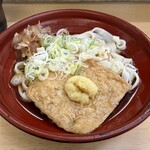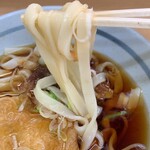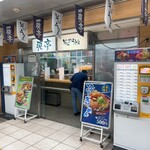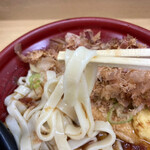
爽亭 JR池袋駅中央口
Soutei ◆ ソウテイ
3.29
Ikebukuro
「Soba」
--
--
Opening hours: [Monday-Saturday]7:00-23:00 [Sunday & Holidays]7:00-22:00 Open Sundays
Rest time: Open daily Open hours and holidays are subject to change, so please check with the store before visiting.
東京都豊島区南池袋1丁目 JR池袋駅改札内コンコース
Photos
(20)




















Details
Reservation Info
No Reservations
Payment Method
Cards not accepted
Electronic money is acceptable (e.g., Suica)
QR code payment is not accepted
Number of Seats
7 seats
(No seating. Standing)
Private Dining Rooms
None
Smoking and Non-Smoking
No smoking at the table
Parking
None
Facilities
Counter seats available
Dishes
Breakfast/morning meal available
Comments
(20)
すずさん ご馳走さま
3.50
I didn't have much time for lunch, so I had standing soba noodles - kishimen. I bought it for 410 yen from the ticket machine. The kishimen took a little time to prepare. It had fried tofu on top, and the broth tasted slightly sweet. The kishimen was slippery and chewy, and I enjoyed it. The restaurant is from the same management as a famous one in Nagoya, and also at Mishima Station. Both places offer a similar volume for 370 yen. It's convenient to have a quick meal at either location. Thank you for the delicious meal.


博史0322
5.00
Shooting JR Ikebukuro Station Central Exit Cold Kishimen 500 yen Just now, I had cold Bukkake soba in Takadanobaba, but since I came all the way to Ikebukuro, I decided to visit here. I heard that you can eat Kishimen from Mr. Sumiyoshi at JR Nagoya Station in Tokyo. It's already late September, but it's still hot. So, this time, I decided to have cold Kishimen again. It seems they use frozen noodles, so it will take a little time. Now, here comes the dish. The white Kishimen noodles are topped with a half piece of fried tofu, grated ginger on top, and plenty of chopped green onions and bonito flakes on the side. The noodles are thick and have a firm texture, probably because they are frozen. The broth has a strong ginger flavor because they generously added grated ginger. I felt like I wanted a bit more bonito flakes on top. Overall, it was delicious as always. Thank you for the meal.



牧村拓
3.60
Around 12:30 on a regular day. Inside JR Ikebukuro Station. Let's have lunch at the station today. I've always been curious about "Sotei" so let's eat there. At first, I thought it was "Sawayakatei," but it's actually pronounced "Sotei." It's a branch of "Kishimen Juyo" which serves delicious kishimen on the Shinkansen platform at Nagoya Station. In front of the "Sotei" shop, I noticed a sign for "Tokyo Kishimen." I decided to try it out. I selected the Tokyo Kishimen for 410 yen from the ticket machine, and it was served to me immediately. The flat noodles do resemble kishimen. Let's dig in. Hmm, the kishimen I had in Nagoya was a bit different. The noodles were smoother and silkier. Also, the broth was a bit lighter and more Kansai-style... I wonder if this rich broth is a characteristic of Tokyo Kishimen. As I pondered this, I finished my meal. I wasn't sure what made it "Tokyo," but it was delicious! Thank you for the meal.

博史0322
5.00
Soothing JR Ikebukuro Station Central Exit Chilled Kishimen for 500 yen. I felt like having kishimen, so I visited here, which is under the same management as Sumiyoshi in Nagoya Station. Although Soothing has many branches, only Ikebukuro and Mishima offer kishimen. It's hot today, so I enjoyed a refreshing chilled kishimen. The toppings included half a piece of fried tofu, bonito flakes, chopped green onions, and a pinch of grated ginger. The bonito flakes were wide and thin, dancing in the steam when served hot. The kishimen is frozen, so it takes a bit of time to prepare, but it has a good chewy texture and firmness. The broth is different from Sumiyoshi's, probably similar to the ones used in other chilled dishes. I haven't been to Nagoya often, but I think Sumiyoshi's broth was slightly lighter in soy sauce flavor. Overall, I enjoyed my meal once again. Thank you for the delicious food.




つきのわのプーさん
3.10
Since Kumatsuka closed down, I've been stopping by Sotei more often. However, with this intense heat, eating warm soba and then moving around makes me sweat a lot. One morning, I realized that I had never ordered cold soba at Sotei before. So I decided to try the cold kitsune soba. It was really refreshing and the noodles were nice and cold. The broth was just the right amount of flavor. They also have cold kishimen available, which might be worth trying with some toppings like fried tofu or tempura bits. I think I'll try the cold kishimen next time.




jfkrfk
3.20
JR Ikebukuro Station has a standing soba restaurant inside the ticket gates. I have eaten here a few times before, but recently found out that it is part of the same chain as the popular restaurant Juyoshi on the Shinkansen platform at Nagoya Station. On this day, I stopped by for a meal after having a drink. Since it was hot outside, I decided to go for the cold kishimen. I purchased a meal ticket from the vending machine and entered the restaurant. I handed over my ticket and soon received my dish. The kishimen quickly cooled down, and it was served with toppings like fried tofu, bonito flakes, and grated ginger. The grated ginger added a refreshing touch to the dish. I immediately started eating the noodles. They had a nice texture typical of kishimen, and the broth was just right in terms of flavor. Mixing in the grated ginger made it even more enjoyable. The fried tofu was not too sweet and tasted delicious. I was also pleased to see bonito flakes on top of the noodles. I finished the dish in no time and felt satisfied.


カネゴン@京都
3.20
After work, I changed trains from the Yamanote Line to the Saikyo Line and found a retro-style restaurant near the stairs leading to the Saikyo Line platform. I decided to try their Tokyo Kishimen for 410 yen. It reminded me of the kishimen I used to eat on my way home from business trips in Matsusaka, Mie Prefecture. The Tokyo Kishimen was softer than the ones in Nagoya, giving it a Kanto-style twist.




我意
2.80
From today for three days, I visited a trade show at Tokyo Big Sight. While transferring trains, I happened to pass by a place that caught my attention and decided to check in. I was delighted to find my favorite chilled kishimen, which I always enjoy at Nagoya Station, available at a shop in Tokyo. The dish consisted of thin fried tofu, bonito flakes, green onions, and ginger in a cold broth, and while it may not compare to the original, it satisfied my craving for kishimen. Thank you for the delicious meal.




misa.nakayama.
3.20
Location: Inside JR Ikebukuro Station, next to the women's restroom. I had the tempura soba after a long time. Back in my student days, I used to come here whenever I was starving. Eating it now, I didn't feel the same excitement as before. Time changes things, doesn't it? However, I still find myself coming here instead of going to the other JR-owned soba place in the station. One of the reasons is the hygienic all-stainless steel kitchen.


池袋コムチ
3.40
I was on a business trip in Isahaya and woke up feeling jet lagged this morning. My body was so sore, I really feel like taking a day off... But I have things to do, so I forced myself to go to work. Today is my first day back to regular work hours, but the new schedule caught me off guard. I don't have to come in first thing in the morning like before, but I want to avoid the crowded train, so I'll be a bit late. I hate it when my daily routine gets messed up the most. I was hungry, so I had cold kishimen for breakfast at this place in Ikebukuro Station for 500 yen. I wonder if the rent is high in JR stations? Honestly, 500 yen for this is expensive, right? I love kishimen, I was hungry, and I need to take my medicine... The cold kishimen at Sotei, as the name suggests, was refreshing! The slightly sweet taste of the fried tofu was nice too. I devoured it. But today I left some soup behind. I don't have any other intentions, but I just couldn't bring myself to slurp it up. Will I be able to switch gears during the long weekend starting tomorrow? It's a bit uncertain... Today's heat is like paradise compared to what it was in Isahaya!




まめぞう
3.50
There are two main types of station stores in JR stations. One is the JR-affiliated stores, now unified under JR East Japan Cross Station Co., Ltd. The other type dates back to the era of Japanese National Railways (JNR), where local businesses were authorized by JNR to operate within station premises, starting with station bento boxes and expanding to include soba noodles, cafes, catering services, and more. These station businesses have since evolved into two main categories: those that have downsized or been absorbed by JR due to changing times, and those that have developed into separate entities like Sakuradori and Ogino-ya. "Sotei," established in August 1949, is operated by Japan Travel Service Co., Ltd. (https://jt-s.net/). Originally commissioned by the Railway Koseikai, it started operating at JNR Odawara Station, Atami Station, and Numazu Station. From June 1959, it switched to direct contracts with various JNR railway administration bureaus, expanding its offerings to include soba, udon, kishimen, ramen, cafes, and standing bars. The famous kishimen shop on the Shinkansen and conventional line platforms at Nagoya Station has been operated by the company since 1961. Currently, it operates at various JR stations, including Nagoya, Chikusa, Ikebukuro, Ueno, Ogikubo, Kokubunji, Noborito, Atami, Mishima, and Toyohashi. Managing a business solely at JR stations or their vicinity is quite an achievement. The Ikebukuro branch of Sotei also specializes in kishimen, leveraging its location at the Shinkansen platform of Nagoya Station. However, navigating the vast terminal of Ikebukuro Station, which serves 4 companies and 8 lines, is like a labyrinth. Even within JR Ikebukuro Station, there are already 48 stores. In the noodle business alone, there are 7 competitors, including IKE Noodle Kitchen, Irori-an Kiraku, Eki Soba Oedo Soba, Sanuki Udon Merikenya IKE Noodle Kitchen, Sobaichi IKE Noodle Kitchen, T's Tantan, and TOKYO Tonkotsu BASE MADE by Ippudo. Amidst this competition, Sotei stands out, but finding it can be a challenge. After a thorough search, it was finally located between the staircases of platforms 1/2 and 3/4, next to the women's restroom. With no financial power like JR East Japan, Sotei maintains an old-fashioned standing-eating style. There are partitions for infection control, providing seating for 7 people. Purchasing a ticket for "Tokyo Kishimen" (410 yen) from the vending machine outside, the noodles are cooked in a tebo and served within 2 minutes. The flat noodles are topped with fried tofu, green onions, and bonito flakes, served in a slightly thicker soy sauce-based broth typical of the Kanto region. Slurping the flat noodles, it's a satisfying kishimen experience. It seems like the hangover from the previous night's drinking has finally worn off. After finishing the meal, the empty bowl and plastic cup are placed on a tray, wiped clean, and the staff thanks you for dining.




すずさん ご馳走さま
4.00
Finally, I was able to have the kishimen that I have been wanting. I had to work in Kuki until after 8:00 PM, so I thought I wouldn't be able to find anywhere open by the time I reached Ikebukuro around 9:30 PM. But to my surprise, Santo in Ikebukuro is open until 11:00 PM on weekdays, which is fantastic. In Mishima, Santo is all about kishimen, but in Ikebukuro, there are many challenging menu options, so it took a while for the kishimen to come around. The cold kishimen for 500 yen was the perfect choice for my tired body in this heat. I was frustrated trying to buy a ticket from the machine, but finally managed to get one and entered the restaurant. There was only one booth available. I handed in my ticket and soon enough, a flat bowl with plenty of bonito flakes arrived. I hurried to repay the lunch I owed. Santo always provides paper aprons, although I don't use them. It's a thoughtful gesture that I appreciate. The dashi broth for the kishimen is the same as the other menu items, and the smooth and chewy kishimen is very easy to eat in this season. Even with plenty of ginger, it wasn't too spicy. The flavor continued until the end, which was nice. The fried tofu was also flavorful and just right. For 500 yen and a stay of about 10 minutes, I left completely satisfied. Thank you for the delicious meal.



spiritoso_expresiva
3.00
After reading the posts of my fellow food enthusiasts, I found out that the company that operates the famous kishimen restaurant "Sumiyoshi" in Nagoya has opened a soba shop in the Kanto region. I took the opportunity of a shopping trip to Ikebukuro after my overnight shift to pay them a visit. It was around noon on a Friday in late June. Upon further research, I learned that the company has a long history and operates various food and beverage businesses not only in the Tokai region but also in Kinki and Kanto regions. I always thought kishimen was synonymous with Nagoya, so I was surprised to find out that the company was based in Tokyo.
I had some trouble finding the location within JR Ikebukuro Station near the central exit and ticket gates. After wandering around, I finally stumbled upon it tucked away discreetly in a corner, away from the main path. I checked the menu at the ticket vending machine outside and was delighted to see they had cold kishimen. With my strong association of kishimen with Nagoya, I didn't hesitate to order the "Cold Kishimen (500 yen)" with a topping of "Shungiku Tempura (190 yen)". The shop only had a counter, with partitions separated by acrylic sheets for COVID-19 prevention. It was full inside, so I waited outside for a spot at the counter. Thankfully, the turnover was quick due to the standing-only setup. I was seated at the counter in less than 5 minutes.
I handed in my ticket and waited for my order. The finished dish was presented in front of me with plenty of bonito flakes and grated ginger on top of the noodles. In Nagoya, they call cold kishimen "Coro", which I never really understood the origin or meaning of. And interestingly, they serve it with fried tofu on top, a style I haven't seen in Nagoya. I started with the cold broth, which was surprisingly salty with a strong soy sauce flavor. The kishimen noodles were chewy, thicker than those at Sumiyoshi in Nagoya, in my opinion. Next, I tried the "Shungiku Tempura", which seemed store-bought and lacked the homemade touch. It felt like a disk of wheat flour with chopped shungiku sprinkled on top. I couldn't help but miss the nostalgia of Sumiyoshi in Nagoya. Maybe I should have gone for the hot broth with meat kishimen instead?




つきのわのプーさん
3.10
It has been six months since the last review, and I realize that I have been using this restaurant more than I thought. It is indeed a convenient and user-friendly place. A lifesaver when in a hurry. There is also Kiraku near our store, but as a bit of an oddball, I prefer the Fukafuka soba made by Kowa Bussan used in this store, which I can stand and eat and enjoy. I mostly eat the burdock tempura and the morning special. The burdock tempura is the most satisfying, and the morning special is the cheapest. I don't really eat anything else, to be honest. Sometimes I have the Tokyo Kishimen, but it takes a bit longer to prepare. I have never ordered the pork ginger soba. I imagine it's like a piece of pork ginger stir-fry on top, maybe. However, I have never seen any other customers ordering it. Well, I might try ordering it once just to see. With the closure of the Kimizuka store, my frequency of use will likely increase even more.




バムセ&マイケル
3.50
Today's Cup "Sotei" @ JR Ikebukuro Station Commercial Area and heading to Ikebukuro❗️My afternoon schedule is packed... At times like this, a convenient stand-up soba shop in the JR Ikebukuro Station premises. This shop has a unique feature where 30% of the customers order the famous "kishimen". I wonder if Tokyoites really like "kishimen" that much❓ So, without hesitation, I ordered the popular "sakura shrimp and deep-fried tempura kishimen". The bowl is topped with plenty of "sakura shrimp tempura", along with "fried tofu" and "bonito flakes". The firm and smooth texture of the "kishimen" is delicious. Every time I go to Nagoya, I end up eating "kishimen" at "Sumiyoshi" on the Shinkansen platform. I never expected to encounter it at a stand-up soba shop in Tokyo like Sotei at JR Ikebukuro Station Central Exit. Tokyo, Toshima-ku, Minami-Ikebukuro 1-chome, JR Ikebukuro Station ticket gate concourse.




ととろ12345
3.20
I bought a large serving of cold shikimen noodles at a location between the south and central 1 ticket gates inside JR Ikebukuro Station. There are two ticket machines that accept Suica. The noodles were topped with bonito flakes, green onions, fried tofu, and grated ginger. Despite being served quickly, the noodles were very cold. They were thin and firm, which was good. When I dissolved the ginger in the dipping sauce, the flavor became a bit blurred. Next time, I want to try the soba noodles. Thank you for the meal.




池袋コムチ
3.40
After work, I suddenly got hungry! Since I don't want it to affect my dinner, what should I have to satisfy my hunger? It was quite hot and uncomfortable today. Oh, I remember there was cold noodles at Sansotei, let's go there! It's convenient because they accept electronic transportation cards, so I don't have to bother with small change these days. The cold noodles cost 500 yen. The ticket machine seemed a bit stuffy, but after a few tries, it finally responded! There was a poster for a "Night Special Mega Serving" for 700 yen at the counter, but it's only available at the Ueno store. Now, the cold noodles had a smaller portion than I expected, so it won't affect my dinner much. Toppings of tempura, green onion, bonito flakes, ginger, very simple. First, mix them together. The broth, noodles, pleasantly cold, instantly cools me down! It may not be as good as the tofu in boxed noodles, but the tempura's perfect sweetness complements the cold noodles beautifully. The bonito flakes and noodles also go well together. It's a satisfying experience, leaving me feeling refreshed! Truly, "Sansotei" (^^)_U~~ It would be even better if it were a bit cheaper... Thank you for the meal.




y_rec
3.30
Today I had work in Ikebukuro. Before heading to work, I decided to have breakfast. I wandered around the station and found a cool-looking shop. They had kishimen, which is perfect for the morning! I chose the Gyudama Kishimen for 650 yen, which comes with raw egg and meat toppings. It's a standing shop without chairs, so I waited a bit for my kishimen to arrive. The thick noodles were delicious when mixed with the soup. Let's break the raw egg and mix the yolk in! The not-too-heavy soup blended well with the noodles. The texture was a bit soft, but it had been a while since I had kishimen. It's true that kishimen tastes better when eaten at a station! There's also a nice soba shop nearby, but personally, I think these kinds of shops are worth cherishing. My stomach is warmed up and I'm sweating, but I'll do my best at work now! Thank you for the meal.




lil-kid
3.20
I saw a soba restaurant called "Sotei" at the station when transferring from Ikebukuro to the Saikyo Line, and it caught my attention. It's right next to the women's restroom, which is quite unique. I was surprised to see that they always have kishimen, which is rare. It turns out that they are from the same company as the popular restaurant "Sumiyoshi" on the Nagoya station platform. I lived in Nagoya for 4 years, so it made me happy to see that. The chewy kishimen was very delicious. Since the portion size is quite small, it's more like a snack for me. Next time, I want to try the warm one to fully enjoy the broth. Although they have curry udon and soba, they don't have kishimen. I wonder if they can make it for me if I ask.




ルナット
3.10
I stopped by on my way back from Asakadai for some errands. When I used to commute through Ikebukuro, I would often come here for dinner. Tonight, I splurged a bit and got the pork and ginger ramen for 530 yen, which was served in about 1 minute. They really don't make you wait long here! The appearance of the ramen with seaweed, ginger, and pork belly on top is quite nice. Oops! I forgot to ask for extra green onions. (laughs) The ginger and seaweed really elevate the usual soup. Thank you for the meal.



Email Login